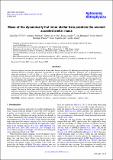Mass of the dynamically hot inner stellar halo predicts the ancient accreted stellar mass
Author(s)
Zhu, Ling; Pillepich, Annalisa; van de Ven, Glenn; Leaman, Ryan; Hernquist, Lars; Nelson, Dylan; Pakmor, Ruediger; Vogelsberger, Mark; Zhang, Le; ... Show more Show less
DownloadPublished version (8.344Mb)
Publisher Policy
Publisher Policy
Article is made available in accordance with the publisher's policy and may be subject to US copyright law. Please refer to the publisher's site for terms of use.
Terms of use
Metadata
Show full item recordAbstract
<jats:p>Galactic dynamical structures are fossil records of the assembly histories of galaxies. By analyzing the cosmological hydrodynamical simulation TNG50, we find that a dynamical structure that we call the “hot inner stellar halo”, defined by stars on dynamically hot orbits with circularity <jats:italic>λ</jats:italic><jats:sub><jats:italic>z</jats:italic></jats:sub> < 0.5 at 3.5 kpc < <jats:italic>r</jats:italic> ≲ 2 <jats:italic>R</jats:italic><jats:sub>e</jats:sub>, is a strong indicator of the mass of accreted satellite galaxies. We find a strong correlation between the mass of this hot inner stellar halo and the total ex situ stellar mass. There is a similarly strong correlation with the stellar mass of the most massive secondary galaxy ever merged. These TNG50 correlations are compatible with those predicted by other simulations, for example by TNG100 across the whole mass range under study (galaxy stellar masses, <jats:italic>M</jats:italic><jats:sub>*</jats:sub>, in the 10<jats:sup>10.3 − 11.6</jats:sup> <jats:italic>M</jats:italic><jats:sub>⊙</jats:sub> range) and by EAGLE for <jats:italic>M</jats:italic><jats:sub>*</jats:sub> ≳ 10<jats:sup>10.6</jats:sup> <jats:italic>M</jats:italic><jats:sub>⊙</jats:sub> galaxies. This shows that our predictions are robust across different galaxy formation and feedback models and hold across a wide range of numerical resolution. The hot inner stellar halo is a product of massive and typically ancient mergers, with inner-halo stars exhibiting three main physical origins: accreted and stripped from massive satellites, dynamically heated by mergers from the bulge and/or disk in the main progenitor, and formed from star formation triggered during mergers. The mass of the hot inner stellar halo defined in this paper is a quantity that can be robustly obtained for real galaxies by applying a population-orbit superposition method to integral-field-unit spectroscopy data, out to a distance of ∼2 <jats:italic>R</jats:italic><jats:sub>e</jats:sub>, which is possible with current observations. Hence, this paper shows that integral-field-unit observations and dynamical models of the inner regions of galaxies provide a way to quantitatively determine the mass of ancient accreted satellites.</jats:p>
Date issued
2022-04Department
MIT Kavli Institute for Astrophysics and Space ResearchJournal
Astronomy & Astrophysics
Publisher
EDP Sciences
Citation
Zhu, Ling, Pillepich, Annalisa, van de Ven, Glenn, Leaman, Ryan, Hernquist, Lars et al. 2022. "Mass of the dynamically hot inner stellar halo predicts the ancient accreted stellar mass." Astronomy & Astrophysics, 660.
Version: Final published version